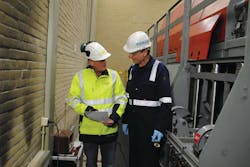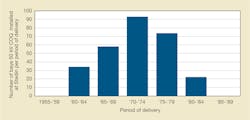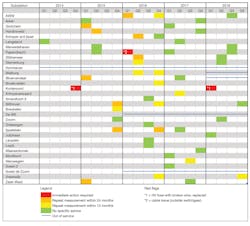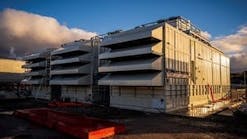For this reason, in 2011, Stedin — which is responsible for Randstad’s high-voltage (HV) sub-transmission system with circuit voltages of 50 kV and 25 kV as well as the medium-voltage distribution network with voltages of 13 kV and 10 kV — decided to implement a two-pronged policy for aging HV switchgear, namely, replacing it within 20 years and preserving switchgear not replaced during that time in cooperation with the OEM or its successor. The utility kicked off its first replacement projects around 2013, and the long-term preservation agreement was signed.
Now, Stedin’s asset management division and Siemens Nederland N.V. are sharing their experience from the first five-year period (2013 to 2018) with the utility’s policy to replace or maintain the 50-kV oil-insulated switchgear, originally manufactured by the Dutch company COQ, now Siemens.
Preservation Strategy
Many COQ minimum oil circuit breakers (MOBs) were installed on the Dutch network, which has operating voltages of 10 kV to 50 kV. Many of these circuit breakers remain in service today. Stedin has about 280 bays in 32 substations at the 50-kV level.
This metal-clad switchgear has an oil-filled main bus bar with oil-filled compartments containing oil-filled tubes, including the arc chambers separated by phase barriers. The compartments are not hermetically sealed. Oil-to-oil bushings with cast-resin insulation are used to connect the tanks electrically. The circuit breaker’s operating mechanism is powered pneumatically. A major problem with the 50-kV COQ switchgear is an oil-to-oil bushing failure that can cause a fire and result in the loss of switchgear.
The preservation strategy agreement between Stedin and Siemens extends from 2013 to 2032 and specifies time-based maintenance and inspections as follows:
- Conduct five-year inspections and operational function testing
- Perform 10-year preventive maintenance and replace aging components, including off-line partial discharge testing of easily accessible insulated circuit breaker/disconnector rods at elevated voltage levels
- Take on-line partial discharge measurements every two and a half years (if prior to maintenance, then measurements are captured followed by a seven-day partial discharge on-line monitoring period).
In addition, Siemens provides services for solving major and minor in-service faults on a 24/7 basis, retaining strategic spares in stock, including serviceable parts recovered from replaced switchgear. Siemens also secures staff with the knowledge and skill to discharge the services outlined in the agreement.
Maintenance Experience
Annual maintenance activities are specified by Stedin and mutually agreed to by Siemens in advance. Planning and maintenance execution were successful in the first five-year period of the agreement. From 2013 to 2018, only two major risks linked to the agreed-upon standards for 50-kV COQ switchgear maintenance were recorded. The risks entailed a breakdown voltage of insulating oil. In one substation, the measured voltage proved to be far too low at 80 kV/cm to 90 kV/cm compared to the specified minimum of 150 kV/cm.
Oil in the switchgear can have a high moisture content and contamination. Because the oil tanks in this particular substation were not hermetically sealed, the switchgear may have been in service for many years in an inappropriate environment (for example, subject to damp and dusty conditions). Substations need to be weather-proof with no ingress of water. This can be a major problem in the Netherlands, where the natural water level is just below ground level. Therefore, dehumidification equipment must be installed to maintain relative humidity below 50%.
In this particular substation, the entrance doors to the switch room were not wind and moisture tight and the installed dehumidifier had insufficient capacity. Therefore, the dehumidifier and entrance doors were replaced. Similar improvements currently are being made to two other substations to meet Stedin’s present standards on ingress of water and relative humidity in buildings.
To restore the oil quality on-site quickly and economically, Siemens designed regenerating equipment that can dry and filter oil during maintenance. Reuse of the existing insulating oil is an acceptable environmental benefit. Also, the resin-impregnated paper parts with an excessive dielectric loss factor — a sign of high moisture content — is dried by Siemens on-site. Dry resin-impregnated spares also are available, if required. Previously, the replacement of all oil-to-oil bushings for thoroughly tested new bushings proved to be labour intensive and costly. Now, replacement bushings are only installed on projects with cable bushings.
To minimize the risk of an oil-to-oil bushing failure, the frequency of taking partial discharge measurements has been set at intervals of two and a half years, based on experience from a fire in 2007 and further research. Since the introduction of partial discharge measurements, no oil-to-oil bushings have indicated partial discharge problems and no breakdowns have occurred in the first five years under the new policy, compared to the previous failure rate of one every two years. This five-year span without a bushing failure could be attributable to several reasons.
Statistically, the probability of five years without an oil-to-oil bushing breakdown is 8.2%. In general, bushings have a life expectancy of between 40 years and 60 years, and since the 1960s, raw material and production techniques have improved and partial discharge factory testing has become more stringent. Also, the cause of failure in the past attributed to bushings may have been incorrect, as the short-circuit current following an oil breakdown may have damaged the bushings; hence, the root cause of the failure may have been misinterpreted.
The overall improvement in oil quality and indoor substation environments also may have contributed to the five-year period without recording an oil bushing fault.
Minor And Major Failures
Eight minor and four major failures in the COQ 50-kV switchgear occurred over the first five-year period. The major failures all involved the pneumatic drivetrain, resulting in a failure to perform the requested switching operation. The monitoring performance procedure includes a comparison of reliability standards with gas-insulated switchgear (GIS) in the voltage range of 60 kV to 100 kV.
During the last four years, with a population of 1200 bay-years, the failure rate of Stedin’s 50-kV circuit breakers has been 0.33 times per 100 bay-years. The international major failure rate of 60-kV to 100-kV GIS is 0.31 failures per 100 bay-years based on a population of 40,000 bay-years. This comparison confirms the reliability of Stedin’s 50-kV COQ circuit breakers is like that of the 60-kV to 100-kV GIS circuit breakers manufactured in the last 30 years. This serves to justify the utility’s decision to preserve and maintain its 50-kV COQ circuit breakers.
Maintaining Knowledge and Skills
For Stedin to continue with its two-pronged strategy for aging HV switchgear until 2032, it is essential to maintain the supply of replacement parts and the knowledge base of the staff employed in maintaining the operational status of the aging switchgear in service. The key considerations are as follows:
- Materials — Regular production of the 50-kV COQ circuit breakers stopped 30 years ago, so replacement parts are no longer available and production of these parts is a time-consuming process, even if production were still possible. However, key spares have been recorded and obtained from stock, manufacturing new components and retaining them from decommissioned switchgear. These components are stored in two of Stedin’s substations that are no longer in service.
- Machine and measurement — The specialized tools and test instruments are available together with a library of drawings, data sheets, test and service reports. They were scanned from the original documentation.
- Resources — Siemens has secured experienced personnel with expertise in maintenance activities and technical support. To ensure this knowledge base is retained, new personnel are recruited well in advance of retirements. This allows time for adequate training and the transfer of knowledge.
An example of the knowledge and skills of Siemens personnel is the development of two new oil-filled cable boxes for the 50-kV COQ circuit breakers, designed to accommodate 50-kV cross-linked polyethylene-insulated cables. The two prototypes, produced in accordance with IEC 62271-209, were type tested successfully by the AIT Institute in Vienna, Austria, and installed on Stedin’s 50-kV network in March 2019.
Replacement Program
During the period of 2012 to 2018, the 50-kV COQ switchgear was replaced in only five substations (25 bays), well below the rate required to complete the replacement of 280 bays in 32 substations by 2032. This replacement programme coincides with rapid changes in the hardware and software associated with substation automation and protection systems, and it is now proving difficult to upgrade the pre-IEC 61850 systems. This task has to be completed at the time of 50-kV switchgear replacements, as it involves changing the layout of the substation.
Another reason why the replacement programme is below the rate required is financial constraints and the risk-per-euro considerations, which favour the replacement of aging 25-kV and 10 kV switchgear because it is cheaper than 50-kV switchgear. Although it has taken time to synchronize the substation automation and COQ programmes and secure internal funding, Stedin began accelerating the replacement of its 50-kV switchgear in 2019.
Future Outlook
As a result of the Paris Climate Agreement and the Dutch government’s decision to reduce carbon dioxide emissions by 49% by 2030, the electricity networks in the Netherlands will change dramatically over the next 15 years. Decentralized solar production may double every two years or three years, as will the number of electric vehicles. The majority of existing gas-driven heating systems in homes and offices will be replaced with district heating systems and electric heat pumps by 2030.
Currently, several large solar plants in the 10-MW to 50-MW range need connections to 50-kV substations, and the connection of fast-charging stations for electric vehicles will increase demand beyond the capacity of many existing 50-kV substations. This will lead to an acceleration in the replacement rate of 50-kV COQ switchgear, as it is now no longer possible to extend them further.
Beyond the mid-2020s, the demand on most of the existing 50-kV substations in urban areas will exceed their capacity because of the increase in heat pump connections and the provision of facilities for electric vehicles. Stedin anticipates this could lead to a change from the existing 150/50/10-kV network to a new 150/23-kV network to meet the increased demand for energy. This would result in 50-kV switchgear being replaced by 150-kV switchgear, a network voltage upgrade that would decrease the capital investment available to replace the 50-kV switchgear in rural areas.
Therefore, it is now likely several 50-kV COQ substations will be operational for more than 60 years. So, the long-term support between Stedin and Siemens will remain, although probably not in all geographical regions.
Acknowledgement
The author wishes to express special thanks to Dirk Boender, of Siemens Nederland N.V., for his collaboration on this article. His contribution includes the information on switchgear maintenance.








